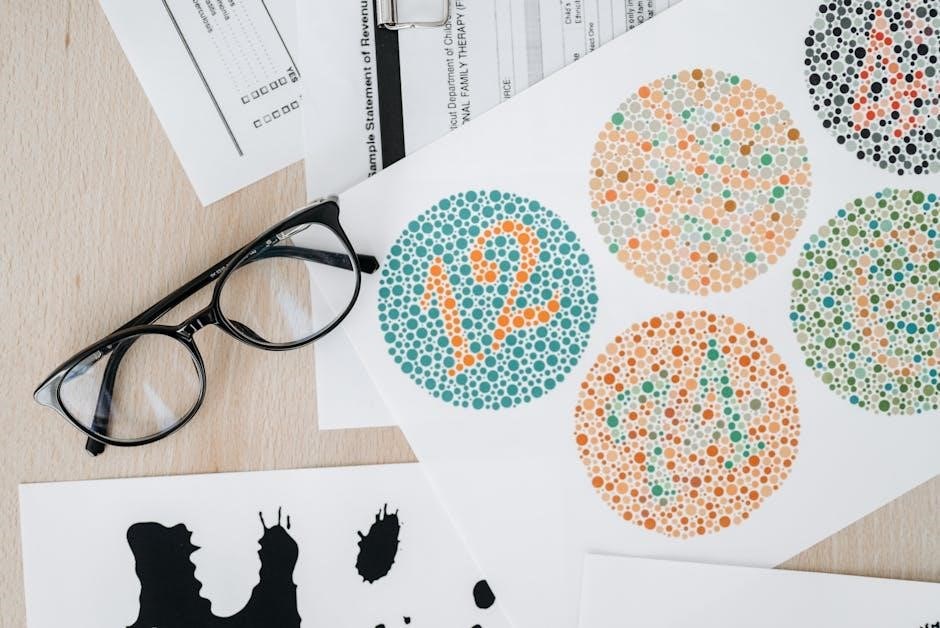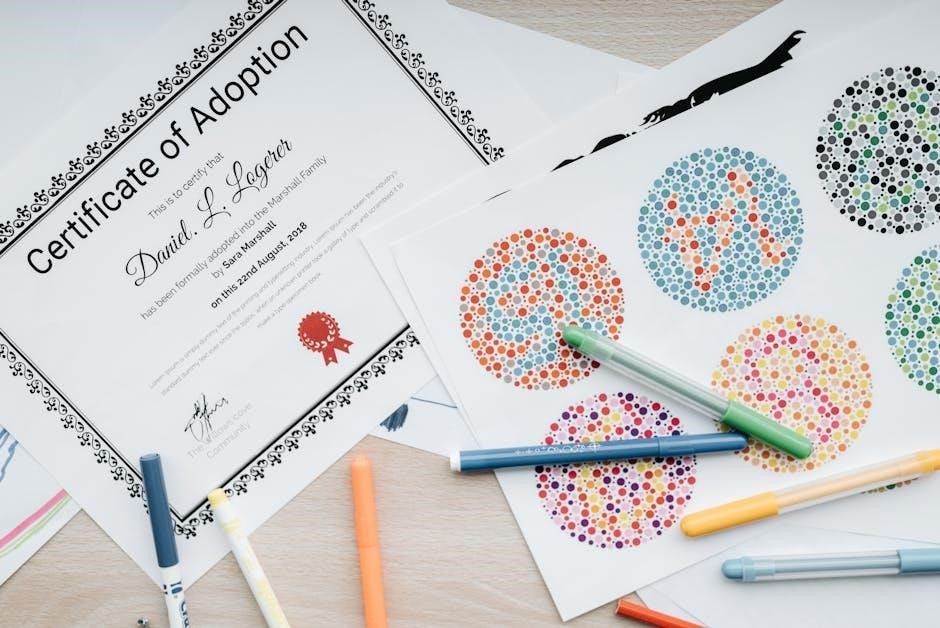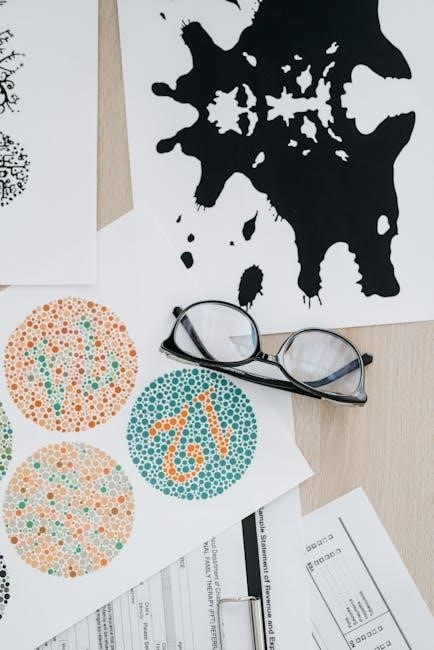The Ishihara Test, created by Dr. Shinobu Ishihara in 1917, is a widely used diagnostic tool for detecting red-green color blindness, available as a PDF for easy access and self-assessment.
Overview of the Ishihara Test
The Ishihara Test is a widely recognized diagnostic tool designed to identify red-green color vision deficiency. Created by Dr. Shinobu Ishihara in 1917, it uses pseudo-isochromatic plates with colored dots to form numbers or shapes visible only to individuals with normal color vision. The test consists of 38 plates, including a demonstration plate and 37 test plates with hidden numbers or patterns. It is a simple yet effective method for detecting color blindness, making it a popular choice for both self-assessment and professional use. The Ishihara Test is available in PDF format, ensuring easy access and printing for individuals worldwide.
History of the Ishihara Test
The Ishihara Test was developed in 1917 by Dr. Shinobu Ishihara, a Japanese ophthalmologist, to diagnose red-green color blindness. Originally designed for the Japanese military, it quickly gained recognition worldwide for its effectiveness. The test uses pseudo-isochromatic plates with colored dots to form numbers visible only to individuals with normal color vision. Over time, the test has evolved, with additional plates added to improve accuracy. Its simplicity and reliability have made it a standard tool in ophthalmology and optometry. Today, the Ishihara Test remains a cornerstone in color vision assessment, widely used in both professional and self-assessment contexts, and is readily available in PDF format for global access.

Structure of the Ishihara Test
The Ishihara Test includes 38 colored plates, starting with a demonstration plate followed by 37 test plates containing hidden numbers or shapes to assess color vision;
Demonstration Plate
The Demonstration Plate, often labeled as Plate 1, is designed to ensure participants understand the test format. It displays the number “12,” visible to everyone, including those with color vision deficiency. This plate serves as a guide to explain how numbers are hidden within the dot patterns. It helps individuals familiarize themselves with the test’s structure before proceeding to the actual diagnostic plates. The demonstration plate is not used for diagnosis but rather as a tool for clear instruction. Its simplicity ensures that participants can focus on identifying patterns in subsequent plates without confusion. This introductory plate is essential for standardized testing conditions.
Test Plates and Hidden Numbers
The Ishihara Test includes 37 plates, each containing hidden numbers or shapes embedded within complex dot patterns. These plates are designed to diagnose red-green color vision deficiency. In normal vision, the numbers are clearly visible, while individuals with deficits may see different numbers or nothing at all. The hidden numbers vary in color and arrangement, testing the ability to distinguish specific hues. Plates are carefully crafted to ensure accuracy and consistency in diagnosis. The hidden numbers are a critical component, as they reveal how the participant’s vision processes color information. This method provides a reliable and efficient way to assess color vision accurately.
Normal and Abnormal Vision Examples
The Ishihara Test provides clear examples of how individuals with normal vision and those with color vision deficiency perceive the plates differently. For instance, Plate 2 displays the number “8” for those with normal vision, while individuals with red-green deficiency see “3.” Similarly, Plate 3 shows “6” for normal vision but “5” for those with a deficiency. These examples highlight the distinct visual experiences, enabling accurate diagnosis. The test includes detailed explanations of what each plate should reveal, making it easier to understand and interpret results. Such examples are crucial for identifying color vision issues and ensuring proper assessment. This clarity aids in early detection and effective management of vision-related concerns.

How to Use the Ishihara Test
The Ishihara Test is used to detect red-green color blindness. View each plate, noting the numbers or shapes seen. Use the PDF version for self-assessment or professional eye exams.
Instructions for Self-Assessment
To use the Ishihara Test for self-assessment, download the PDF version and ensure proper viewing conditions. Sit in natural light, 75 cm away from the test. Start with Plate 1, which displays “12” for everyone, confirming the test is viewed correctly. Proceed through each plate, noting the numbers or shapes you see. If no number is visible, mark it as such. Plates 2-17 are critical for assessing red-green vision. Compare your results with the answer key provided. If you identify fewer than 12 numbers correctly, consult an eye care professional for further evaluation. This self-assessment tool is user-friendly, making it ideal for initial screening at home.
Professional Use in Eye Exams
The Ishihara Test is widely used by optometrists and ophthalmologists in clinical settings to diagnose color vision deficiencies. During eye exams, the test is administered under controlled lighting conditions to ensure accuracy. Patients are shown the 38 plates, starting with Plate 1, which serves as a control. Individuals with normal vision can see numbers like “12,” while those with red-green deficiency may see different numbers or nothing. The test’s sensitivity and specificity make it a reliable tool for professionals. However, it is often used alongside other tests, like the Farnsworth-Munsell 100 Hue Test, for comprehensive assessment. The Ishihara Test is a key component in identifying and confirming color vision deficiencies in professional eye care.

Interpreting the Results
Passing requires at least 12 correct answers out of 14 plates, indicating normal color vision. Scores below 12 suggest a color vision deficiency, with 97% sensitivity and 100% specificity.
Passing Score and Sensitivity
A passing score on the Ishihara Test requires correctly identifying at least 12 out of 14 test plates, excluding the demonstration plate. This threshold indicates normal color vision, while scores below 12 suggest a color vision deficiency. The test demonstrates 97% sensitivity and 100% specificity, making it highly reliable for detecting red-green color blindness. Sensitivity refers to the test’s ability to correctly identify those with color vision deficiency, while specificity ensures that individuals with normal vision are not falsely diagnosed. Plate 1, a demonstration, is not included in the scoring, as it is designed to familiarize users with the test format. Accurate interpretation of results is essential for proper diagnosis and further evaluation if needed.
Understanding Color Vision Deficiency
Color vision deficiency, often referred to as color blindness, is a condition where individuals struggle to distinguish certain colors, most commonly red and green. The Ishihara Test is specifically designed to identify red-green color blindness, the most prevalent form of color vision deficiency. It uses pseudo-isochromatic plates, where numbers or shapes are embedded in dot patterns, visible only to individuals with normal color vision. Those with deficiency may see different numbers, no numbers, or distorted patterns. Early detection is crucial, as it impacts daily activities, career choices, and overall quality of life. The test aids in diagnosing conditions like protanopia (red-blindness) and deuteranopia (green-blindness), enabling timely interventions and adaptations.

Types of Color Vision Deficiency
The Ishihara Test primarily detects red-green color blindness, including protanopia (red-blindness) and deuteranopia (green-blindness). It also identifies other deficiencies, though less effectively, aiding comprehensive diagnosis and adaptation strategies.
Red-Green Color Blindness

Red-green color blindness is the most common type of color vision deficiency, affecting approximately 8% of males and 0.5% of females. It is inherited and present from birth, making it difficult to distinguish between red and green hues. The Ishihara Test effectively identifies this condition through its pseudo-isochromatic plates. These plates contain hidden numbers visible to individuals with normal vision but appear as a different number or no number at all to those with red-green color blindness. Early detection is crucial for adapting to daily challenges and ensuring proper educational and professional accommodations. The test’s simplicity and accuracy make it a cornerstone in diagnosing this condition.
Other Vision Disorders Detected
Beyond red-green color blindness, the Ishihara Test can also identify other vision disorders. For instance, it can detect protanopia and deuteranopia, which are specific types of red and green color vision deficiencies. Additionally, the test may reveal issues with visual acuity or other color perception abnormalities. While primarily designed for color vision assessment, its comprehensive nature allows it to uncover a broader range of visual impairments, aiding in early detection and appropriate management. This makes the Ishihara Test a valuable tool for both self-assessment and professional eye exams, contributing to overall eye health and vision care.

Advantages of the Ishihara Test
The Ishihara Test is simple, effective, and widely available in PDF format, making it accessible for both self-assessment and professional use in identifying color vision deficiencies.
Simple and Effective Design
The Ishihara Test is renowned for its simplicity and effectiveness. It uses colored dot patterns to form hidden numbers, visible only to individuals with normal color vision. This design allows for quick and accurate detection of red-green color blindness. The test’s straightforward nature makes it accessible for self-assessment and professional use. Its PDF format ensures easy printing and digital accessibility, enabling widespread use. The clarity of the plates and their ability to reveal specific numbers provide reliable results. This uncomplicated yet precise design has made the Ishihara Test a cornerstone in color vision assessment for over a century, offering a user-friendly solution for identifying vision deficiencies effectively.
Wide Availability in PDF Format
The Ishihara Test is widely available in PDF format, making it easily accessible for both self-assessment and professional use. Many websites offer free downloads of the complete 38 plates, allowing individuals to print and use them instantly. The PDF version ensures that the test is portable and can be shared without losing quality. Its digital format also enables quick distribution and use on various devices. This accessibility has contributed to its popularity worldwide. Whether for personal use or in clinical settings, the Ishihara Test in PDF format remains a convenient and reliable tool for assessing color vision deficiency effectively.

Download and Accessibility

The Ishihara Test PDF is widely available online, offering free downloads of the complete 38 plates for easy printing and use in self-assessment or professional settings.
PDF Versions for Easy Printing
The Ishihara Test is widely available in PDF format, making it accessible for both self-assessment and professional use. These PDF versions contain all 38 plates, including the demonstration plate and 37 test plates with hidden numbers or shapes; The PDF format ensures high-quality resolution, maintaining the clarity of the colored dots necessary for accurate testing. Users can easily download and print the PDF from various online platforms, such as The Great Stampede or TemplateRoller, without requiring special software. This convenience allows individuals to assess color vision deficiency in the comfort of their own homes or in clinical settings, ensuring widespread usability and accessibility.
Online Platforms for Instant Use
Several online platforms offer the Ishihara Test for immediate use, eliminating the need for printing. Websites like PicassoSciences and others provide interactive versions where users can take the test directly on their devices. These platforms display the plates sequentially, allowing individuals to input their responses digitally. Some sites, such as Velhagen, offer additional tools like score interpretation and detailed explanations. This digital accessibility makes the test convenient for quick assessments without requiring downloads or printing. Online versions are particularly useful for self-assessment and educational purposes, ensuring that color vision testing is readily available to a broad audience worldwide.

Limitations of the Test
The Ishihara Test may be misinterpreted without proper guidance, and its reliance on self-reporting can lead to inaccurate results, requiring professional oversight for reliable diagnosis.
Potential for Misinterpretation
The Ishihara Test’s results can be misinterpreted if not administered correctly, as individuals may guess numbers or see patterns differently. Without proper guidance, the test may yield inaccurate conclusions. Additionally, some cases of color vision deficiency might be overlooked due to the subjective nature of the test. The reliance on self-reporting also introduces variability, as individuals may interpret the dots differently. This underscores the importance of professional oversight to ensure accurate diagnosis and avoid misleading results. Proper training and standardized conditions are essential to minimize interpretation errors and ensure the test’s effectiveness in detecting color vision deficiencies.
Need for Comprehensive Eye Exams
While the Ishihara Test is effective for detecting color vision deficiency, it is not a substitute for a comprehensive eye exam. A full eye examination evaluates various aspects of vision, including visual acuity, eye pressure, and retinal health, which the Ishihara Test does not assess. Professional eye care professionals can identify other potential issues, such as glaucoma or macular degeneration, that might go undetected with the Ishihara Test alone. Regular, thorough eye exams are essential for maintaining overall eye health and ensuring early detection of any vision-related problems. Relying solely on the Ishihara Test may lead to missed diagnoses of other critical eye conditions.
The Ishihara Test remains a vital tool for detecting color vision deficiency, offering simplicity and accessibility in PDF format while highlighting the need for future advancements in testing methods.
Importance of the Ishihara Test
The Ishihara Test is a cornerstone in diagnosing color vision deficiency, particularly red-green blindness. Its simplicity and effectiveness make it a widely used tool globally. The test’s design, using pseudo-isochromatic plates, ensures that individuals with normal vision can identify numbers or shapes, while those with deficiencies may see different results or nothing at all. This method provides a quick and reliable initial assessment, making it invaluable for early detection. Its accessibility in PDF format has further enhanced its reach, allowing both professionals and individuals to use it conveniently. While it is not a comprehensive diagnostic tool, its role in identifying potential issues is unparalleled, emphasizing the need for further professional evaluation. Its impact on eye care and occupational screenings cannot be overstated.
Future Developments in Color Vision Testing
Future advancements in color vision testing aim to enhance accuracy and accessibility. Digital tools, such as AI-powered apps, are being developed to offer more precise diagnostics. These technologies can adapt to individual vision types, providing personalized assessments. Additionally, genetic research holds promise for understanding and addressing color vision deficiencies at a molecular level. The integration of machine learning may improve test sensitivity and reduce false positives. Telemedicine platforms are also expected to expand, enabling remote testing and reaching underserved populations. These innovations will complement traditional methods like the Ishihara Test, ensuring earlier and more accurate detection of color vision issues, while also offering new avenues for research and treatment.